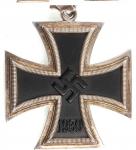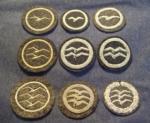
Harrier
Past Contributor-
Posts
432 -
Joined
-
Last visited
Content Type
Profiles
Forums
Blogs
Gallery
Events
Store
Everything posted by Harrier
-
Bundesrepublik knight's cross iron cross 1957
Harrier replied to Roeland's topic in Germany: Post 1945: Bundesrepublik & DDR
So it is your view, Prosper, that between 1945 and, at the earliest, 1949, S&L had no silver on hand with which to produce crosses, and also had no leftover stocks of frames (the same having been impounded and melted down)? What do you say about the apparent use by Deumer, in its production of 1957 EK's, of frames stamped L/11? (Edit: forgot to add - Would they have differentiated between grades of silver content?) Very interesting and I would certainly like to hear more. Best, Harrier -
Bundesrepublik knight's cross iron cross 1957
Harrier replied to Roeland's topic in Germany: Post 1945: Bundesrepublik & DDR
That is a beautiful early '57 RK! It is interesting to see on this piece (and also on the early piece posted in the link), the beading flaws on the 3, 6 and 9 o'clock arms. It would be very interesting to see a full breakdown showing, on these "Type B" cross frames, the full and exact progression from the earliest, minor, beading flaws to the most heavily involved flawing on multiple arms. Even Dietrich's fine work on the RK, which shows a difference in exact bead locations between flawing on the "A" type frame when compared to the "B" type, does not contain such a study. -
http://gmic.co.uk/uploads/monthly_06_2009/post-2778-1244173656.jpgGreat photos here and thanks for sharing them! There are many strange Luftwaffe related uniforms. Here is a Luftwaffe cufftitle I have had for years and which I have always felt was related to the quasi-military security services used by the Luftwaffe for some airbase security work. I believe a photo exists in one of the reference books of one of these fellows in a uniform very similar to the one in the photo which started this post. He wears a cap like the fire service cap, but with a Luftwaffe style wreath without wings.
-
EK 1939 Knights Cross Original?
Harrier replied to TheKnight's topic in Germany: All Eras: The Iron Cross
In original Knights Crosses, the frames are die-struck with the suspension ring being a part of the frame. The dies were prepared by a master engraver and, under magnification, the stamped frames exhibit very, very small flaws which do not appear when a piece has been created by a machine or computer assisted design program. I urge you to intensively study Knights Crosses if you intend to buy one. You should obtain the books written by Gordon Williamson, Dietrich Maerz, Vern Bowen and others, and should also read the numerous forum discussions regarding these pieces. -
EK 1939 Knights Cross Original?
Harrier replied to TheKnight's topic in Germany: All Eras: The Iron Cross
http://gmic.co.uk/uploads/monthly_05_2009/post-2778-1243266363.jpgThe cross initially posted was meant to look similar to this Zimmermann/Godet cross. -
EK 1939 Knights Cross Original?
Harrier replied to TheKnight's topic in Germany: All Eras: The Iron Cross
I think the cross posted by Bill is another example of this same type cross, just aged a bit more. -
EK 1939 Knights Cross Original?
Harrier replied to TheKnight's topic in Germany: All Eras: The Iron Cross
These crosses appeared for the first time not many years ago. Here is one brief discussion touching on them on another Forum: http://www.wehrmacht-awards.com/forums/sho...ht=latvian+fake One of the many problems with them is that the suspension ring, which is an integral part of a Knights Cross frame when it is die-struck, is separately attached to this cross, although an effort has been made to make it look like it is part of the frame. These crosses are available with multiple markings from Juncker, S&L, etc., etc.. Close study of the beading will also show that it is remarkably regular. Although real crosses also have what appears to be regular beading, on close examination you can see the small irregularities which are characteristic of a human touch in the preparation of the master die. On this cross, it is apparent that a machine created the master die for the frame, not a human. -
Uniform overview
Harrier replied to Paul R's topic in Germany: Third Reich: Uniforms, Headwear, Insignia & Equipment
Very nice (and some very hard to find!) uniforms here. Thanks for posting! -
Just arrived - Sample board from S & L
Harrier replied to Stijn David's topic in State, Civil Awards & Decorations
http://gmic.co.uk/uploads/monthly_05_2009/post-2778-1243092545.jpgThought I'd bring this topic back up so some more cloth badges can be shown. -
EK 1939 Knights Cross Original?
Harrier replied to TheKnight's topic in Germany: All Eras: The Iron Cross
P.S. The ribbon is incorrect as well. -
EK 1939 Knights Cross Original?
Harrier replied to TheKnight's topic in Germany: All Eras: The Iron Cross
This cross is not very old and is one of a "recent" crop of fakes which came on the scene in the last few years. It is believed to originate in Eastern Europe and is called a "Latvian fake" (which may or may not be accurate). The beading appears to be the product of a CAD or laser-cutting system and the ring appears to be separately attached to the frame. -
Luftwaffe Makers?
Harrier replied to François SAEZ's topic in Wehrmacht Medals, Decorations & Awards
Nice early badges. -
Mainland Europe would be my guess, judging from the surroundings, although the aircraft IS in tropical paint. The fuselage band looks like a "Defense of the Reich" stripe. The enlisted aircrew wearing flight jackets seem to indicate the base was being used by multi-engine U.S. aircraft.
-
Kriegsmarine S&L Schnellboot badge 1st model
Harrier replied to 2dresq's topic in Wehrmacht Medals, Decorations & Awards
Gordon, I agree with with you completely. S&L had large stocks of completed stamped planchets left in the immediate postwar period (which it had actually MADE, on premises, during the war) but DID NOT have large stocks of pins, catches, hinges, etc. (which it "outsourced" from other suppliers and did NOT make on premises). Thus, we see (once its smaller stock of fittings ran out) perfectly real planchets "married" to incorrect or unusual fittings, obtained AFTER the war, to complete badges. To me, it makes perfect sense (given the relatively high cyclic rate of die-stamping) that there would almost always be more stamped planchets already existing in on-premises stock than there would be the fittings necessary to complete all that had been stamped. S&L would have enough fittings to complete a specific order (and some extras), but would not re-order fittings until they were needed to process another actual order. After the war, they were able to complete some badges with what was "on-hand", but before too long had to resort to fittings never originally used on a particular badge during the war itself. Who knows where these new fittings came from? Regards, Harrier -
Kriegsmarine S&L Schnellboot badge 1st model
Harrier replied to 2dresq's topic in Wehrmacht Medals, Decorations & Awards
The "o" mark is simply a position indicator for use by workers. As far as I have been able to determine from examination of multiple examples,there are three meanings: the "o" by itself, with no adjacent hardware, simply indicates the reverse of a piece being assembled. A single "o" towards the bottom of a reverse of a piece indicates where the bottom piece of hardware (a catch) should go (or, in the case of something like the Oakleaves to the Knights Cross, where the bottom curve of the attachment loop should be). More than one "o" indicates the placement location of rivets or other "like" hardware. By example, American aircrew "wings" made in Germany after the war have "o" marks on either end of the reverse of the wings to indicate where the "posts" are soldered to the wing. There is a lot of talk, but NO proof, that S&L really re-commenced the actual new manufacture of Nazi awards right after the war (i.e. actual die-stamping of awards). There is, on the other hand, substantial proof that it DID engage in the assembly of such awards, from leftover original stock, after the war. In the immediate postwar period, workers sold leftover stock (from S&L and other Ludenscheid companies) to soldiers as souvenirs. Some of that stock was finished and "ready for shipment". Some was not and in many cases workers assembled unfinished pieces, which are detectable by lack of finish, sloppy rivetting and poorly affixed (but all original) hardware. Later (probably beginning in the mid-1950's) original remaining (but unfinished) stamped planchets were, in fact, subjected to a sort of "manufacture process" in that they were given a "finish" (often not matching the finish used during the war) and were fitted with the type of hardware we see on 1957 type "re-issues". No one has yet been able to produce a Nazi badge from S&L which can be demonstrated to have been made right after the war "from the ground up" and using all new parts. This is heresy in much of the collecting world, but I, for one, would very much like to see any proof to the contary. -
Kriegsmarine KM items
Harrier replied to nesredep's topic in Germany: Third Reich: Uniforms, Headwear, Insignia & Equipment
The boards and wreath are fine. Sorry, but can't help on the label. -
Thanks, Jeff! An interesting combination. Fellow seems to have qualified for 6 Pacific battle stars and multiple LOM's and Bronze Stars ( if those are holes for additional awards on the ribbon), but no Navy Cross or Navy DSM or aviation-related awards. Would be nice to figure this one out.



